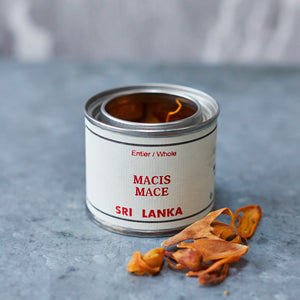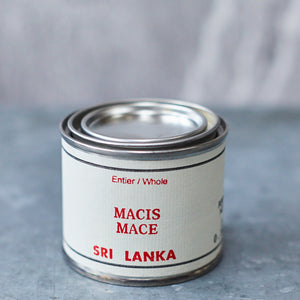- Home
- Shop
- About
- Recipes
- Videos
- Press
- Stockists
- Trade Enquiries
- Contact
-
GBP £
Épices de Cru Mace
£14.50
In a nutshell: Our Sri Lankan mace blades have a delicate floral and citrus flavour, perfect for flavouring cauliflower cheese, shepherds pie, meat pies and chutneys.
Mace has a flavour that is immediately familiar to anyone, yet often difficult to identify in spice mixes. Mace is, actually, the delicate aril, blade or husk that grows around the whole nutmeg shell. It contains the same aromatic oils as nutmeg but in different proportions making its taste a little more elusive, with delicate floral and subtle citrus notes. It takes 8 years before the evergreen Nutmeg tree (Myristica fragrans), a tree that can grow up to 24 metres high, bears fruit. Once the small, white fleshed ripen, they expose a single brown nutmeg seed enrobed in a single red mace aril. The mace is carefully stripped away from the seed, flattened and dried till it reaches its characteristic orange colour.
Like many spices originating in the Indonesian Spice islands, mace made its way into Alexandria in the 6th century and then began its journey into the cuisines of Europe via the crusaders. Today, its also popular in the Caribbean and North Africa.
More expensive than nutmeg, it can be used in a variety of dishes and appears in stocks and sauces, pickles, sausage mixes, meat pies and chutney. Try it in a shepherds pie or cauliflower cheese and add to hot mulled wines and cider punches.
Used to season Indian pulaos (rice dishes) and garam masala. Mace is a perfect poultry spice (very good for the Christmas turkey or goose) and is wonderful in desserts such as carrot cake. It’s a great dessert spice in general, and can be found in old-fashioned doughnut recipes. We prefer delicate mace over nutmeg when making many homemade spice blends. If you want to grind it finely, simply use a coffee grinder.
Details 15g
About Épices de Cru
Épices de Cru began in 1982 as a catering partnership between Philippe and Ethné de Vienne. Their mission was a kind of “cooking pot anthropology:” learning the secrets of family cooking around the world and applying these techniques to the needs of hungry Montrealers. The secret, they learned, was spices. Over the last two decades, Philippe and Ethné have searched for the world’s best spices, accompanied by their children, Marika and Arik. The de Viennes believe in direct sourcing spices: visiting growing regions, spending time with growers, and developing personal relationships that last decades. In 2004, they officially opened their first spice shop in Montreal’s fantastic Jean Talon market– it’s since become a mecca for foodies from all over the world. I first visited in 2008 and have been buying and using their spices on a regular basis ever since that first exciting visit. They steadfastly maintain that they do nothing original, only facilitating the exchange of culinary common sense from one place to another. But, what they do is simply quite brilliant - by providing us with the finest quality ingredients, and their superb spice mixes, we can all experiment with unusual spices and recreate delicious recipes from around the world.
Collections: Spices & Herbs
You may also like
News & Updates
Sign up to get the latest on sales, new releases and more…
HELPFUL LINKS
VISIT THE EALING GROCER
Our new neighbourhood food store is now open for all Vinegar Shed products plus everyday staples, fruit & veg, cheese & charcuterie, provisions, kitchenalia & food to go.
18 St. Mary’s Road, Ealing, London, W5 5ES. Tel: 0208 566 0632
Opening times:
Tuesday-Saturday 9AM to 5PM
Sunday 9AM to 3PM
© 2025 Vinegar Shed. | Photography by David Loftus | Powered by Shopify





